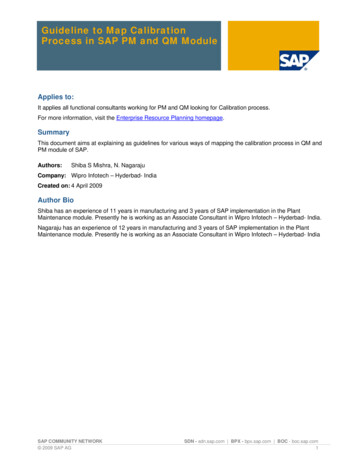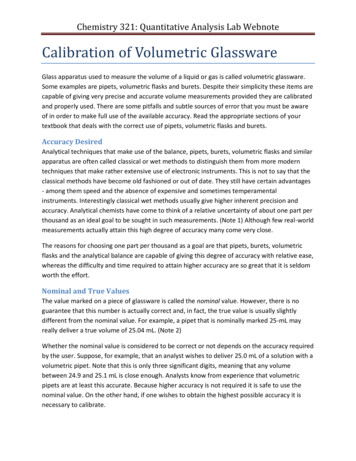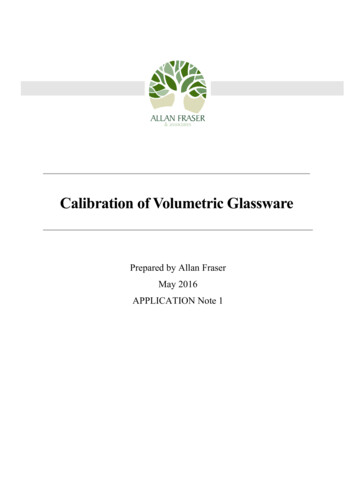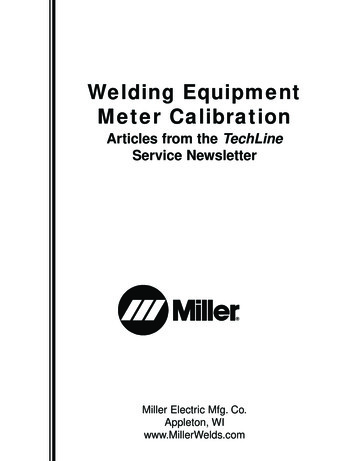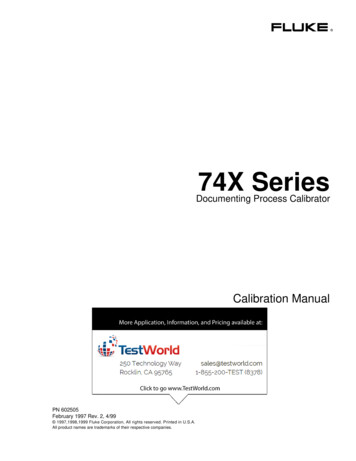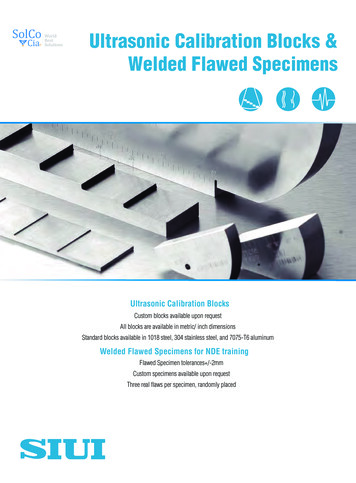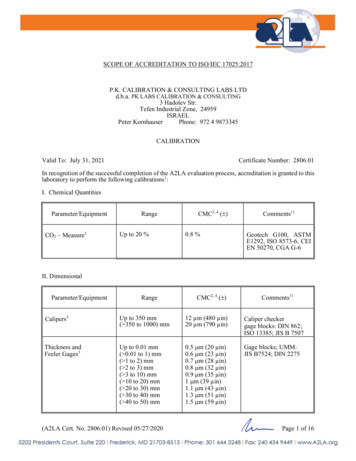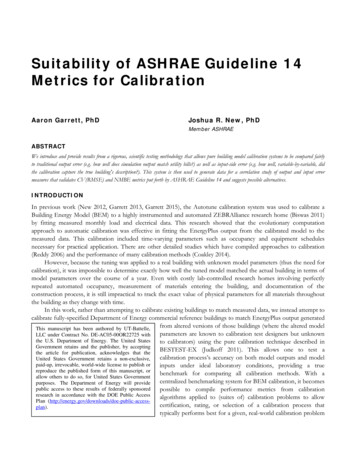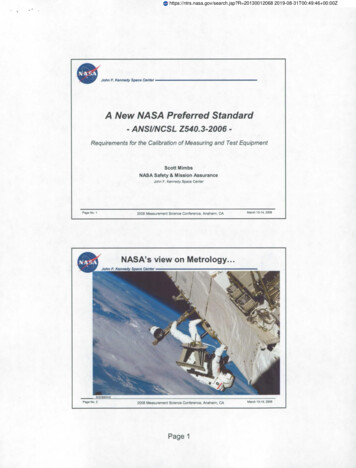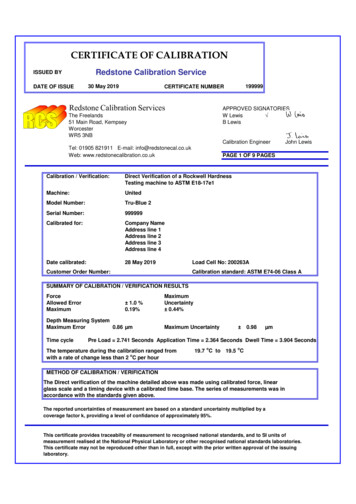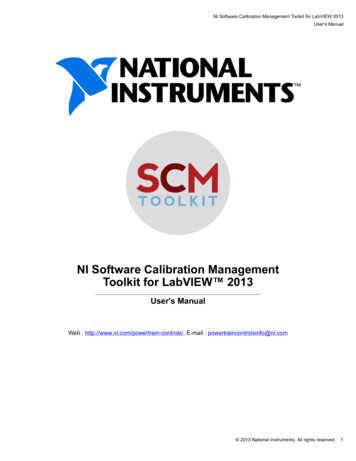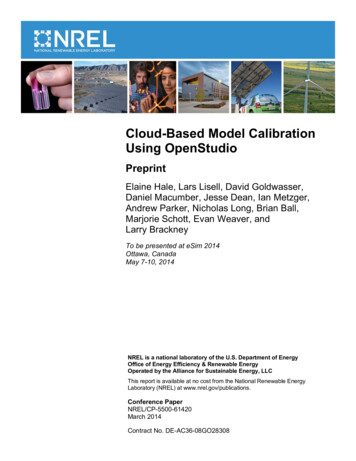
Transcription
Cloud-Based Model CalibrationUsing OpenStudioPreprintElaine Hale, Lars Lisell, David Goldwasser,Daniel Macumber, Jesse Dean, Ian Metzger,Andrew Parker, Nicholas Long, Brian Ball,Marjorie Schott, Evan Weaver, andLarry BrackneyTo be presented at eSim 2014Ottawa, CanadaMay 7-10, 2014NREL is a national laboratory of the U.S. Department of EnergyOffice of Energy Efficiency & Renewable EnergyOperated by the Alliance for Sustainable Energy, LLCThis report is available at no cost from the National Renewable EnergyLaboratory (NREL) at www.nrel.gov/publications.Conference PaperNREL/CP-5500-61420March 2014Contract No. DE-AC36-08GO28308
NOTICEThe submitted manuscript has been offered by an employee of the Alliance for Sustainable Energy, LLC(Alliance), a contractor of the US Government under Contract No. DE-AC36-08GO28308. Accordingly, the USGovernment and Alliance retain a nonexclusive royalty-free license to publish or reproduce the published form ofthis contribution, or allow others to do so, for US Government purposes.This report was prepared as an account of work sponsored by an agency of the United States government.Neither the United States government nor any agency thereof, nor any of their employees, makes any warranty,express or implied, or assumes any legal liability or responsibility for the accuracy, completeness, or usefulness ofany information, apparatus, product, or process disclosed, or represents that its use would not infringe privatelyowned rights. Reference herein to any specific commercial product, process, or service by trade name,trademark, manufacturer, or otherwise does not necessarily constitute or imply its endorsement, recommendation,or favoring by the United States government or any agency thereof. The views and opinions of authorsexpressed herein do not necessarily state or reflect those of the United States government or any agency thereof.This report is available at no cost from the National Renewable EnergyLaboratory (NREL) at www.nrel.gov/publications.Available electronically at http://www.osti.gov/scitechAvailable for a processing fee to U.S. Department of Energyand its contractors, in paper, from:U.S. Department of EnergyOffice of Scientific and Technical InformationP.O. Box 62Oak Ridge, TN 37831-0062phone: 865.576.8401fax: 865.576.5728email: mailto:reports@adonis.osti.govAvailable for sale to the public, in paper, from:U.S. Department of CommerceNational Technical Information Service5285 Port Royal RoadSpringfield, VA 22161phone: 800.553.6847fax: 703.605.6900email: orders@ntis.fedworld.govonline ordering: http://www.ntis.gov/help/ordermethods.aspxCover Photos: (left to right) photo by Pat Corkery, NREL 16416, photo from SunEdison, NREL 17423, photo by Pat Corkery, NREL16560, photo by Dennis Schroeder, NREL 17613, photo by Dean Armstrong, NREL 17436, photo by Pat Corkery, NREL 17721.Printed on paper containing at least 50% wastepaper, including 10% post consumer waste.
Cloud-Based Model Calibration Using OpenStudioElaine Hale1, Lars Lisell1, David Goldwasser1, Daniel Macumber1, Jesse Dean1,Ian Metzger1, Andrew Parker1, Nicholas Long1, Brian Ball1, Marjorie Schott1,Evan Weaver1, Larry Brackney11National Renewable Energy Laboratory, Golden, ColoradoAbstractOpenStudio is a free, open source Software Development Kit (SDK)and application suite for performing building energy modeling andanalysis. The OpenStudio Parametric Analysis Tool (PAT) was extended to allow cloud-based simulation of multiple OpenStudio models parametrically related to a baseline model. This paper describes thenew cloud-based simulation functionality and presents a model calibration case study. Calibration is initiated by entering actual monthlyutility bill data into the baseline model. Multiple parameters are thenvaried over multiple iterations to reduce the difference between actualenergy consumption and model simulation results, as calculated andvisualized by billing period and by fuel type. Simulations are performed in parallel using the Amazon Elastic Compute Cloud service.This paper highlights model parameterizations (measures) used forcalibration, but the same multinodal computing architecture is available for other purposes; for example, recommending combinations ofretrofit energy saving measures using the calibrated model as the newbaseline.1IntroductionTo prevent climate change and to save money, institutionally and as individuals, we havestarted expecting our built environment to continually become more energy efficient. Thisamounts to periodically auditing the energy use of individual buildings via a five-part process:(1) make a basic determination of how much energy the building as a whole, and perhaps individual pieces of equipment, use; (2) investigate the main drivers of that energy use; (3) explore ways the building and its occupants might use less energy; (4) choose and implementchanges in equipment and/or operation; and (5) evaluate the efficacy of our actions and repeatthis process as needed.This paper discusses the design and use of software tools that support the first twosteps of this process; i.e., quantifying the energy used by a building, and then finalizing asimulation model that can be used to trace energy use to specific end uses and pieces ofequipment. The software tools can also support steps 3 and 4: exploring and helping stakeholders choose between various retrofit measures, see Macumber et al. (2014). The overallprocess can be undertaken at various levels of detail. The focus here is on an ASHRAE levelII energy audit, where the baseline is represented by a simulation model calibrated to monthlyutility data, and we seek to identify basic retrofit measures (ASHRAE 2004).The calibration of building energy models to utility and other types of performancedata has been an active area of research for over 20 years (Carroll and Hitchcock 1993; Clarkeet al. 1993; Reddy 2006). The area remains active because it has proven difficult to build toolsand techniques that do not rely on an unaffordable level of expertise to identify model parameters that should be calibrated, and in the end verify that the calibrated model end use breakdowns are likely to be reasonable compared to the actual building. This issue can be decisive-1This report is available at no cost from the National Renewable Energy Laboratory (NREL) at www.nrel.gov/publications.
ly overcome with sufficient hourly or subhourly submetered (by end use) data, and significantcomputation time; but that solution remains impractical for all but special situations (New etal. 2012). If an auditor has limited performance data, some structure, leading to computationalsavings, can be imposed on the workflow by breaking the calibration down into steps alignedwith weather-independent and -dependent parts of the model (Westphal et al. 2005; Yoon etal. 2003). Sensitivity analysis also plays a large role in trying to keep the number of calibratedparameters reasonable compared to the limited performance data to be matched by the modelresults. Even so, the temptation to over-fit and over-simulate is strong. For instance, Reddy,Maor, and Panjapornpon (2007) fit models using 20-24 parameters where Sun and Reddy(2006) would recommend 5-6 parameters, overcoming this issue somewhat by recommendingretrofits based on the 20 best-calibrated models rather than on a single “solution.”Bayesian calibration addresses the overfitting problem and provides outputs in supportof uncertainty quantification of retrofit energy conservation measures (ECMs) (Heo et al.2012; Heo et al. 2014). The mathematical approach can be applied to fully detailed (EnergyPlus) models, but is more often used with normative models to keep the computational burden manageable. The main insight is that for the cost of requiring auditors to document uncertainty information for each input, Bayesian statistical methods can be used to transform theauditor’s rough bounds (prior distributions) on parameters into posterior distributions that reflect the likely parameter value given the available evidence. The fact that the prior distributions are modified only as the evidence requires is one form of regularization; i.e., trusting theinitial model as much as possible in the face of an underdetermined (more variables thanmeasurements) problem. Even so, the method “ still relies heavily on experts’ judgementsespecially in the choice of calibration parameters, quantification of their prior distribution,and quantification of uncertainties in other parameters. This will remain so until a repositoryfor standard estimates of parameter uncertainty for [a] variety of building cases becomesavailable” (Heo et al. 2012).Without (yet) the ability to gather uncertainty information from auditors, and the limited data available from a level II audit, we conceptualize model calibration as follows:1. Gather data (detailed geometry and equipment counts, rough schedule information) in the field.2. Construct an energy model and run the simulation.3. Note areas of disagreement between the simulation and energy consumption data.4. Look for gross errors in the initial data, how the data were represented in the model, or areas where there is higher uncertainty in the initial data.5. Make adjustments and iteratively repeat the process until a satisfactory outcome isachieved (a model whose monthly energy performance matches the utility datawith an acceptable amount of error as outlined in ASHRAE Guideline 14).Such a workflow does not fully validate the accuracy of the final model. However, this process is supported by a standardized method for constructing the initial model (simuwatt Energy Auditor), and by standardized workflows and visualizations in the OpenStudio applicationsuite; discourages overfitting; and can be extended when more data (performance or uncertainty) become available. Thus, the workflow represents an important step toward makingsimulation-based audits more affordable and common.Section 2 elaborates on our approach to calibrating building energy models to monthlyutility data; Section 3 describes the software tools built to support users in this workflow; Section 4 dives deeply into a case study associated with a demonstration performed for the USDepartment of Defense’s (DoD) Environmental Security Technology Certification Program(ESTCP); and Section 5 summarizes next steps.2This report is available at no cost from the National Renewable Energy Laboratory (NREL) at www.nrel.gov/publications.
2Hand Calibration to Monthly Utility DataComprehensive ASHRAE levels II and III energy audits require a calibrated energy model toaccurately predict the energy savings of each ECM (ASHRAE 2004). Energy model calibration requirements are outlined in ASHRAE Guideline 14, and are applied to electricity use(kWh), electricity demand (kW), and all other fuels used in the facility, as data are available(ASHRAE 2002). The baseline energy model is typically calibrated to monthly utility billsusing actual meteorological year (AMY) weather data. ASHRAE Guideline 14 uses two statistical indices to characterize the accuracy of the calibrated model: the mean bias error(MBE) and the coefficient of variation of the root mean squared error CV(RMSE). The MBEindicates how well the model predicts energy consumption as compared to the measured data.Positive values indicate that the model overpredicts actual values; negative values indicatethat the model underpredicts actual values. RMSE values indicate the overall uncertainty inthe prediction of whole-building energy use. Using monthly data the MBE must be 5% andthe RSME must be 15%. Energy auditors typically calibrate the baseline model to slightlyunderpredict energy use so the energy savings predictions are less likely to overestimate energy savings. The amount of data collected during an energy audit depends on the level of theenergy audit, the sophistication of the building automation system (BAS), and the types ofonsite metering systems (for electricity and natural gas). Assuming an ASHRAE level II energy audit was conducted at a facility with a standard BAS, the following input parameters aretypically collected: Building geometry and orientation Building operational schedules Lighting fixture and electric equipment types and counts by space Occupant density by space or space type Window and door construction and window to wall ratios HVAC system characteristics, capacities, zoning, set point temperatures, operationalschedules, and control sequences Building construction characteristics (if up-to-date drawings are available). Utility data for each fuel type Process loadsTypically a number of these input parameters are only partially characterized within acertain range of possible values, especially lighting schedules, plug load schedules, specificbuilding construction characteristics (in some cases), infiltration schedules, and variousHVAC operation and maintenance issues. Thus, the precision of the entire process is limitedby the precision of the input data, and some of these inputs invariably need to be adjusted in acalibration process. Complicating matters, even though hundreds, or thousands (depending onhow schedules are parameterized) of parameters are required to fully instantiate a buildingenergy model, it is common for monthly utility bill data to be the only energy use data available. For a single year, this typically amounts to 12, 24, or 36 data points; i.e., 12 readings eachfor electrical energy, electricity demand, and heating fuel. Mathematically, this yields an incredibly underdetermined problem (many more variables than measurements).Why not Optimization?Although calibration (also called inverse modeling or data fitting) is often formulated as anoptimization problem, that approach runs into some difficulty because one could easily specify many more parameters to be tuned than there are data points to match. This highly underdetermined problem, if formulated and sol
tion requirements are outlined in ASHRAE Guideline 14, and are applied to electricity use (kWh), electricity demand (kW), and all other fuels used in the facility, as data are available (ASHRAE 2002). The baseline energy model is typically calibrated to monthly utility bills using actual meteorological year (AMY) weather data. ASHRAE Guideline 14 uses two sta- tistical indices to characterize .
